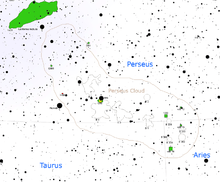Perseus molecular cloud
| Molecular cloud | |
|---|---|
| Giant molecular cloud | |
 Map of the Perseus molecular cloud | |
| Observation data: J2000.0[1] epoch | |
| Right ascension | 03h 35.0m[1] |
| Declination | +31° 13′[1] |
| Distance | 600 ly |
| Apparent dimensions (V) | 6°×2° |
| Constellation | Perseus |
| Designations | Perseus Molecular Cloud, Perseus Cloud, Per MCld, Per Mol Cloud, Perseus Complex, PMC [1] |
The Perseus molecular cloud (Per MCld) is a nearby (600 ly) giant molecular cloud in the constellation of Perseus and contains over 10,000 solar masses of gas and dust covering an area of 6 by 2 degrees. Unlike the Orion molecular cloud it is almost invisible apart from two clusters, IC 348 and NGC 1333, where low-mass stars are formed. It is very bright at mid and far-infrared wavelengths and in the submillimeter originating in dust heated by the newly formed low-mass stars.
It shows a curious ring structure in maps made by the IRAS and MSX satellites and the Spitzer Space Telescope and has recently detected by the COSMOSOMAS at microwave frequencies as a source of anomalous "spinning dust" emission.
References
- 1 2 3 4 "NAME Perseus Cloud". SIMBAD. Centre de données astronomiques de Strasbourg. Retrieved 2014-03-14.
- Bally, J.; Walawender, J.; Johnstone, D.; Kirk, H.; Goodman, A. (December 2008). "The Perseus Cloud". Handbook of Star Forming Regions, Volume I: the Northern Sky ASP Monograph Publications. 4: 308. Bibcode:2008hsf1.book..308B. ISBN 978-1-58381-670-7.
- Kirk, Helen; Johnstone, Doug; Di Francesco, James (August 2006). "The Large- and Small-Scale Structures of Dust in the Star-forming Perseus Molecular Cloud". The Astrophysical Journal. 646 (2): 1009–1023. arXiv:astro-ph/0602089. Bibcode:2006ApJ...646.1009K. doi:10.1086/503193.
- More on THE ASTROPHYSICAL JOURNAL http://iopscience.iop.org/0004-637X/656/1/293
This article is issued from
Wikipedia.
The text is licensed under Creative Commons - Attribution - Sharealike.
Additional terms may apply for the media files.